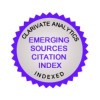Prediyabetli ve Prediyabeti Olmayan Bireylerde Retinopati: Prospektif Klinik Tabanlı Karşılaştırmalı Çalışma
Abstract
Amaç: Prediyabet, diabetes mellitus (DM) tanısı için gerekli sınırlara ulaşmayan bir hiperglisemi ara durumudur. DM'nin kronik mikrovasküler komplikasyonu olan retinopati, 20-65 yaş arası kişilerde önlenebilir körlüğün en yaygın nedenidir. Bu çalışma, prediyabetli ve prediyabeti olmayan bireylerde retinopati varlığını araştırmayı amaçlamıştır.
Yöntem: Çalışmaya, Nisan ve Eylül 2022 tarihleri arasında bir hastanenin periyodik sağlık muayenesi polikliniğini ziyaret eden, prediyabet tanısı konmuş 56 hasta ve ek kronik hastalıkları ne olursa olsun prediyabet veya diyabet tanısı konmamış 47 kişi dahil edilmiştir. Ölçümler arasında ağırlık, vücut kitle indeksi, bel ve kalça çevresi, sistolik-diyastolik kan basıncı ve çeşitli laboratuvar testleri yer almıştır. Her hasta, görme keskinliği, göz içi basıncı, ön segment ve fundus muayeneleri ile Spektral alan optik koherens tomografi kullanılarak merkezi foveal kalınlık ve ortalama foveal kalınlık ölçümlerini içeren tam bir oftalmolojik muayeneden geçirildi.
Bulgular: 56 prediyabetik hastanın birinde diyabetik retinopati, 2 hastada ise hipertansif retinopati saptandı. Prediyabetik olmayan grupta diyabetik retinopati saptanmazken, 2 kişide hipertansif retinopati mevcuttu. Prediabetik ve prediabetik olmayan gruplar arasında retinopati görülme sıklığı açısından anlamlı bir fark yoktu (p=0,796).
Sonuç: Çalışmada, prediyabetik ve prediyabetik olmayan hastalar arasında diyabetik retinopati insidansında anlamlı bir fark gözlenmemiştir. Ancak, prediyabetik hastalarda kan basıncının düzenlenmesi, lipid panellerinin izlenmesi ve kilonun kontrol edilmesi, DM'ye ilerlemenin önlenmesi için çok önemlidir.
Keywords
References
- 1. Hostalek U. Global epidemiology of prediabetes-present and future perspectives. Clinical diabetes and endocrinology. 2019;5(1):5.
- 2. Chen L, Magliano DJ, Zimmet PZ. The worldwide epidemiology of type 2 diabetes mellitus--present and future perspectives. Nature reviews Endocrinology. 2011;8(4):228-36.
- 3. Harreiter J, Roden M. [Diabetes mellitus-Definition, classification, diagnosis, screening and prevention (Update 2019)]. Wiener klinische Wochenschrift. 2019;131(Suppl 1):6-15.
- 4. Simó-Servat O, Hernández C, Simó R. Diabetic retinopathy in the context of patients with diabetes. Ophthalmic research. 2019;62(4):211-7.
- 5. Wu L, Fernandez-Loaiza P, Sauma J, Hernandez-Bogantes E, Masis M. Classification of diabetic retinopathy and diabetic macular edema. World journal of diabetes. 2013;4(6):290.
- 6. Kirthi V, Nderitu P, Alam U, Evans JR, Nevitt S, Malik RA, et al. The prevalence of retinopathy in prediabetes: A systematic review. Survey of ophthalmology. 2022.
- 7. Knowler WC, Barrett-Connor E, Fowler SE, Hamman RF, Lachin JM, Walker EA, et al. Reduction in the incidence of type 2 diabetes with lifestyle intervention or metformin. 2002.
- 8. Chen X, Zhao Y, Zhou Z, Zhang X, Li Q, Bai L, et al. Prevalence and risk factors of diabetic retinopathy in Chongqing pre-diabetes patients. Eye. 2012;26(6):816-20.
- 9. Kahn HA, Hiller R. Blindness caused by diabetic retinopathy. American journal of ophthalmology. 1974;78(1):58-67.
- 10. Wong TY, Islam FA, Klein R, Klein BE, Cotch MF, Castro C, et al. Retinal vascular caliber, cardiovascular risk factors, and inflammation: the multi-ethnic study of atherosclerosis (MESA). Investigative ophthalmology & visual science. 2006;47(6):2341-50.
- 11. Wong TY, Duncan BB, Golden SH, Klein R, Couper DJ, Klein BE, et al. Associations between the metabolic syndrome and retinal microvascular signs: the Atherosclerosis Risk In Communities study. Investigative ophthalmology & visual science. 2004;45(9):2949-54.
- 12. Varma R, Macias GL, Torres M, Klein R, Peña FY, Azen SP, et al. Biologic risk factors associated with diabetic retinopathy: the Los Angeles Latino Eye Study. Ophthalmology. 2007;114(7):1332-40.
- 13. van Leiden HA, Dekker JM, Moll AC, Nijpels G, Heine RJ, Bouter LM, et al. Risk factors for incident retinopathy in a diabetic and nondiabetic population: the Hoorn study. Archives of ophthalmology. 2003;121(2):245-51.
- 14. Robles-Rivera RR, Castellanos-González JA, Olvera-Montaño C, Flores-Martin RA, López-Contreras AK, Arevalo-Simental DE, et al. Adjuvant therapies in diabetic retinopathy as an early approach to delay its progression: the importance of oxidative stress and inflammation. Oxidative medicine and cellular longevity. 2020;2020.
- 15. Johnson RJ, Perez-Pozo SE, Sautin YY, Manitius J, Sanchez-Lozada LG, Feig DI, et al. Hypothesis: could excessive fructose intake and uric acid cause type 2 diabetes? Endocrine reviews. 2009;30(1):96-116.
- 16. Yamada T, Fukatsu M, Suzuki S, Wada T, Joh T. Elevated serum uric acid predicts impaired fasting glucose and type 2 diabetes only among Japanese women undergoing health checkups. Diabetes & metabolism. 2011;37(3):252-8.
- 17. Oda E, Kawai R, Sukumaran V, Watanabe K. Uric acid is positively associated with metabolic syndrome but negatively associated with diabetes in Japanese men. Internal medicine. 2009;48(20):1785-91.
- 18. Guney SC, Cay Y, Yildirim Simsir I, Kabaroglu C, Afrashi F, Saygili LF. The prevalence and risk factors of retinopathy and nephropathy in prediabetic population. International Journal of Diabetes in Developing Countries. 2022:1-8.
- 19. Şanibaş AV, Cakmak F, Baydar İ, Binici DN. Investigation of the Effectiveness of the ADA Prediabetes Risk Test in Identifying Prediabetic Turkish Patients and Determination of the Frequency of Retinopathy in Prediabetic Patients. New Trends in Medicine Sciences. 2023;4(1):40-7.
Retinopathy in Individuals With and Without Prediabetes: A Prospective Clinic-Based Comparative Study
Abstract
Objective: Prediabetes is an intermediate state of hyperglycemia that does not reach the diagnostic limits of diabetes mellitus (DM). Retinopathy, a chronic microvascular complication of DM, is the most common cause of preventable blindness in people aged 20-65. This study aimed to investigate the presence of retinopathy in individuals with and without prediabetes.
Methods: The study included 56 patients diagnosed with prediabetes, who visited the periodic health examination outpatient clinic of a hospital between April and September 2022, and 47 people without a diagnosis of prediabetes or diabetes, regardless of their additional chronic diseases. Measurements taken included weight, Body mass index (BMI), waist and hip circumference, and systolic-diastolic blood pressure, along with various laboratory tests. Each patient underwent a complete ophthalmologic examination, which included assessments of visual acuity, intraocular pressure, anterior segment and fundus examinations, and measurements of central foveal thickness (CFT) and mean foveal thickness (MFT) using Spectral field optical coherence tomography (SD-OCT).
Results: Diabetic retinopathy was found in 1 of the 56 prediabetic patients, and hypertensive retinopathy in 2 patients. In the non-prediabetic group, no diabetic retinopathy was found, but hypertensive retinopathy was present in 2 individuals. There was no significant difference in the occurrence of retinopathy between the prediabetic and non-prediabetic groups (p=0.796).
Conclusion: The study observed no significant difference in the incidence of diabetic retinopathy between patients with and without prediabetes. However, maintaining blood pressure regulation, monitoring lipid panels, and controlling weight in prediabetic patients are crucial to preventing the progression to DM.
Ethical Statement
Permission for this study was obtained from Duzce University Non-Interventional Health Research Ethics Committee (Decision No: 2022/48- Date: 25.04.2022).
References
- 1. Hostalek U. Global epidemiology of prediabetes-present and future perspectives. Clinical diabetes and endocrinology. 2019;5(1):5.
- 2. Chen L, Magliano DJ, Zimmet PZ. The worldwide epidemiology of type 2 diabetes mellitus--present and future perspectives. Nature reviews Endocrinology. 2011;8(4):228-36.
- 3. Harreiter J, Roden M. [Diabetes mellitus-Definition, classification, diagnosis, screening and prevention (Update 2019)]. Wiener klinische Wochenschrift. 2019;131(Suppl 1):6-15.
- 4. Simó-Servat O, Hernández C, Simó R. Diabetic retinopathy in the context of patients with diabetes. Ophthalmic research. 2019;62(4):211-7.
- 5. Wu L, Fernandez-Loaiza P, Sauma J, Hernandez-Bogantes E, Masis M. Classification of diabetic retinopathy and diabetic macular edema. World journal of diabetes. 2013;4(6):290.
- 6. Kirthi V, Nderitu P, Alam U, Evans JR, Nevitt S, Malik RA, et al. The prevalence of retinopathy in prediabetes: A systematic review. Survey of ophthalmology. 2022.
- 7. Knowler WC, Barrett-Connor E, Fowler SE, Hamman RF, Lachin JM, Walker EA, et al. Reduction in the incidence of type 2 diabetes with lifestyle intervention or metformin. 2002.
- 8. Chen X, Zhao Y, Zhou Z, Zhang X, Li Q, Bai L, et al. Prevalence and risk factors of diabetic retinopathy in Chongqing pre-diabetes patients. Eye. 2012;26(6):816-20.
- 9. Kahn HA, Hiller R. Blindness caused by diabetic retinopathy. American journal of ophthalmology. 1974;78(1):58-67.
- 10. Wong TY, Islam FA, Klein R, Klein BE, Cotch MF, Castro C, et al. Retinal vascular caliber, cardiovascular risk factors, and inflammation: the multi-ethnic study of atherosclerosis (MESA). Investigative ophthalmology & visual science. 2006;47(6):2341-50.
- 11. Wong TY, Duncan BB, Golden SH, Klein R, Couper DJ, Klein BE, et al. Associations between the metabolic syndrome and retinal microvascular signs: the Atherosclerosis Risk In Communities study. Investigative ophthalmology & visual science. 2004;45(9):2949-54.
- 12. Varma R, Macias GL, Torres M, Klein R, Peña FY, Azen SP, et al. Biologic risk factors associated with diabetic retinopathy: the Los Angeles Latino Eye Study. Ophthalmology. 2007;114(7):1332-40.
- 13. van Leiden HA, Dekker JM, Moll AC, Nijpels G, Heine RJ, Bouter LM, et al. Risk factors for incident retinopathy in a diabetic and nondiabetic population: the Hoorn study. Archives of ophthalmology. 2003;121(2):245-51.
- 14. Robles-Rivera RR, Castellanos-González JA, Olvera-Montaño C, Flores-Martin RA, López-Contreras AK, Arevalo-Simental DE, et al. Adjuvant therapies in diabetic retinopathy as an early approach to delay its progression: the importance of oxidative stress and inflammation. Oxidative medicine and cellular longevity. 2020;2020.
- 15. Johnson RJ, Perez-Pozo SE, Sautin YY, Manitius J, Sanchez-Lozada LG, Feig DI, et al. Hypothesis: could excessive fructose intake and uric acid cause type 2 diabetes? Endocrine reviews. 2009;30(1):96-116.
- 16. Yamada T, Fukatsu M, Suzuki S, Wada T, Joh T. Elevated serum uric acid predicts impaired fasting glucose and type 2 diabetes only among Japanese women undergoing health checkups. Diabetes & metabolism. 2011;37(3):252-8.
- 17. Oda E, Kawai R, Sukumaran V, Watanabe K. Uric acid is positively associated with metabolic syndrome but negatively associated with diabetes in Japanese men. Internal medicine. 2009;48(20):1785-91.
- 18. Guney SC, Cay Y, Yildirim Simsir I, Kabaroglu C, Afrashi F, Saygili LF. The prevalence and risk factors of retinopathy and nephropathy in prediabetic population. International Journal of Diabetes in Developing Countries. 2022:1-8.
- 19. Şanibaş AV, Cakmak F, Baydar İ, Binici DN. Investigation of the Effectiveness of the ADA Prediabetes Risk Test in Identifying Prediabetic Turkish Patients and Determination of the Frequency of Retinopathy in Prediabetic Patients. New Trends in Medicine Sciences. 2023;4(1):40-7.
Details
| Primary Language | English |
|---|---|
| Subjects | Health Services and Systems (Other) |
| Journal Section | Articles |
| Authors | |
| Publication Date | October 29, 2025 |
| Submission Date | August 1, 2024 |
| Acceptance Date | October 23, 2025 |
| Published in Issue | Year 2025 Volume: 17 Issue: 3 |
Cite




